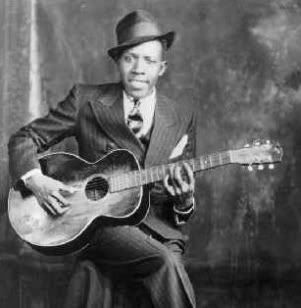
By MattMarshall
Legendary blues guitarist Robert Johnson, who’s folklore story of selling his soul to the devil to play guitar has become embedded in popular culture, was allegedly found to have lived far beyond the day of his supposed death on August 16th, 1938.
Historical blues researchers Jason Rewald and Flow Niloh claim to have found definitive evidence and eyewitness accounts that, instead of dying after a bar room poisoning, the legendary blues guitarist eventually moved to the outskirts of New Albany, a small town in northern Mississippi. There, he married at least twice before passing away from liver failure at age 54 at the home of his common law wife, Rose Devereaux. According to Niloh, the blues man’s real date of passing was September 6th, 1965, nearly thirty years after the previously believed date.
Robert Johnson’s unique style of blues guitar was widely influential to modern rock legends such as Eric Clapton, George Harrison of the Beatles, Jack White of the White Stripes, Led Zeppelin’s Jimmy Page and many others. A Rock and Roll hall of fame inductee, his 29 song album, the extent of his previously known recorded catalog, won a posthumous Grammy in 1990.
His alleged death, strychnine poisoning at the hands of a jealous husband, is well known and has been hotly debated by blues affectionados for decades. Very little hard evidence exists on the life of the blues man; even the site of his final resting place is the source of controversy, with no less than three separate graveyards having laid claim to his burial. According to Niloh and other sources familiar with Johnson, prior to the recent findings, no verifiable new evidence has been uncovered about the blues man in nearly thirty years.
“Simply remarkable” says Matt Marshall, editor at American Blues Scene. “Johnson was the foundation of music as we knew it, and to finally find real evidence of his life is nothing short of a miracle.” Mississippi was deeply segregated until well after Johnson’s death, and it was not uncommon for census records, death records, and even grave markers of black community members to go unrecorded, making it easy for African Americans to change their names and move around unnoticed.
Only two verified pictures have been found of the blues man. However, Niloh claims to now possess a third, “well kept, easily identifiable” image — a picture of Johnson and his wife Deveraux standing in front of a screen door, (Johnson’s famous guitar is not in the picture). The picture, possibly a wedding or anniversary photo, belongs to 81 year old Samantha Phillips, the sister of the late Deveraux, who passed away in 1981. She never remarried.
The stunning find ignites the search for another widely sought-after and elusive discovery: Johnson’s previously unknown recorded music. According to Phillips, Johnson had left briefly “to make recordings” during his marriage to Deveraux. While she did not possess a copy of the album, nor could she recall the location of his recordings, the mere mention of the existence of more recordings could set off a gold rush to find the priceless records.
While searching for a census record, The pair of researchers stumbled upon a 1960 Tunica county record bearing the name “Robert Spencer”, a surname Johnson had at one time identified himself by. After following up on the record, they discovered a marriage certificate to Deveraux (nearly 20 years Robert’s junior) under Johnson’s real name. After an exhaustive search, they were able to identify a living witnesses to the marriage, Deveraux’s sister. She described Johnson in detail, including his stunning guitar capabilities, and readily identified Johnson when shown his famous “photo booth” picture. Interestingly, while Johnson is perhaps the most well known blues player to have lived, according to Rewald, Phillips claimed that Johnson was known for his ability to play a wide range of music, including gospel, bluegrass, and popular radio ballads. According to Phillips, he was known in the surrounding area by his stage name “Dusty Robert”, though he rarely traveled beyond Tunica.
The name Robert Johnson was fairly common. However, according to Niloh, Phillips provided several details that should help identify the Robert Johnson in question as the “real” Robert Johnson, including the town of his birth, Hazelhurst, Mississippi. Phillips says Johnson never knew of his widespread fame, even during the resurgence of his music’s popularity in the 1960s, over 30 years after his original recording.
----------------------------------------------------------------------------------------------------------------------------------------------------------------------
The Robert Johnson Blues Foundation (heirs of the Robert Johnson Estate) Have requested to use this video for their Centennial Celebration and has also commissioned a second Video using the LOST PHOTO of R.J. This will not be uploaded to youtube until after May 2011. But can be viewed in Mid-Feb 2011 at http://www.robertjohnsonbluesfoundation.org/. R.A. Grimes uses the only two photos and Studio Software to bring legendary Blues Man Robert Johnson to life. Two music videos Hell hound on my trail and Devils Blues.
http://www.americanbluesscene.com/2011/04/blues-legend-robert-johnson-found-to-have-lived-years-after-supposed-death/
No comments:
Post a Comment